Related Research Articles
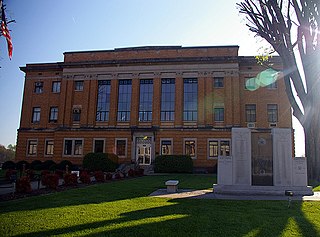
McDowell County is a county located in the U.S. state of North Carolina. As of the 2020 census, the population was 44,578. Its county seat is Marion.

Gaston County is a county in the U.S. state of North Carolina. As of the 2020 census, the population was 227,943. The county seat is Gastonia. Dallas served as the original county seat from 1846 until 1911.

Catawba County is a county in the U.S. state of North Carolina. As of the 2020 census, the population was 160,610. Its county seat is Newton, and its largest city is Hickory. The county is part of the Hickory–Lenoir–Morganton, NC Metropolitan Statistical Area.

Caldwell County is a county in the U.S. state of North Carolina. It is located in the foothills of the Blue Ridge Mountains. As of the 2020 census, the population was 80,652. Its county seat is Lenoir. Caldwell County is part of the Hickory–Lenoir–Morganton, NC Metropolitan Statistical Area.

Burke County is a county located in the U.S. state of North Carolina. As of the 2020 census, the population was 87,570. Its county seat is Morganton. Burke County is part of the Hickory–Lenoir–Morganton, NC Metropolitan Statistical Area.

Valdese is a town in Burke County, North Carolina, United States. The population was 4,689 at the 2020 census. It is part of the Hickory-Lenoir-Morganton Metropolitan Statistical Area. One of the largest Waldensian congregations in the United States was founded in the town in the late nineteenth century, now known as the Waldensian Presbyterian Church. The town was settled by immigrants from the Cottian Alps in the Piedmont region of Italy.
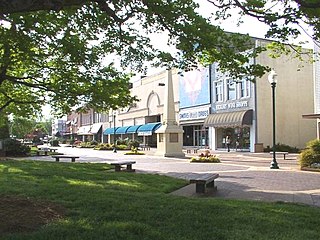
Hickory is a city located primarily in Catawba County, with formal boundaries extending into Burke and Caldwell counties. The city lies in the U.S. state of North Carolina. At the time of the 2020 census, Hickory's population was 43,490. Hickory is the principal city of the Hickory–Lenoir–Morganton Metropolitan Statistical Area, in which the metro population at the 2020 census was 365,276. Hickory is located approximately 60 miles (97 km) northwest of Charlotte, North Carolina.

Lake James State Park is a North Carolina state park in Burke and McDowell Counties, North Carolina in the United States. Located near Nebo, North Carolina, it covers 3,743 acres (15.15 km2) and borders 6,510-acre (26 km2) Lake James.

The Catawba River originates in Western North Carolina and flows into South Carolina, where it later becomes known as the Wateree River. The river is approximately 220 miles (350 km) long. It rises in the Appalachian Mountains and drains into the Piedmont, where it has been impounded through a series of reservoirs for flood control and generation of hydroelectricity. The river is named after the Catawba tribe of Native Americans, which lives on its banks. In their language, they call themselves "yeh is-WAH h’reh", meaning "people of the river."
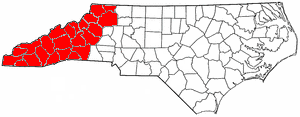
Western North Carolina is the region of North Carolina which includes the Appalachian Mountains; it is often known geographically as the state's Mountain Region. It contains the highest mountains in the Eastern United States, with 125 peaks rising to over 5,000 feet in elevation. Mount Mitchell at 6,684 feet, is the highest peak of the Appalachian Mountains and mainland eastern North America. The population of the region, as measured by the 2010 U.S. Census, is 1,473,241, which is approximately 15% of North Carolina's total population.

The Great Indian Warpath (GIW)—also known as the Great Indian War and Trading Path, or the Seneca Trail—was that part of the network of trails in eastern North America developed and used by Native Americans which ran through the Great Appalachian Valley. The system of footpaths extended from what is now upper New York to deep within Alabama. Various Indians traded and made war along the trails, including the Catawba, numerous Algonquian tribes, the Cherokee, and the Iroquois Confederacy. The British traders' name for the route was derived from combining its name among the northeastern Algonquian tribes, Mishimayagat or "Great Trail", with that of the Shawnee and Delaware, Athawominee or "Path where they go armed".
The South Mountains are an ancient and deeply eroded mountain range in western North Carolina. They are an isolated remnant of the much larger Appalachian Mountains to the west, and are separated from the Appalachians by the Catawba River valley. The range covers approximately 100,000 acres (400 km²) in Burke, Cleveland, McDowell and Rutherford counties. The South Mountains are the highest and most rugged chain of the isolated mountain ranges which dot North Carolina's Piedmont region. The highest point in the range is Icy knob which rises to 3,000 feet above sea level. The South Mountains are heavily forested with Southeastern mixed forests. Water erosion from numerous rivers and streams has given the mountains narrow ridges and valleys.

Lake James is a large reservoir in the mountains of Western North Carolina which straddles the border between Burke and McDowell Counties. It is named for tobacco tycoon and benefactor of Duke University James Buchanan Duke. The lake, with surface elevation of 1200 ft, lies behind a series of 4 earthen dams. It was created by Duke Power between 1916 and 1923 as a hydro-electric project. It still generates power today and is the uppermost lake on the Catawba River system.

The Hickory–Lenoir–Morganton Metropolitan Statistical Area, as defined by the United States Census Bureau, is an area consisting of four counties in the Catawba Valley region of western North Carolina. Local residents often refer to the area as the Unifour, although this name is largely unknown outside of the region.
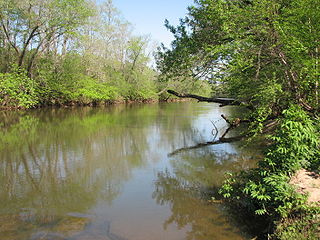
Mayo River State Park is a North Carolina state park in Rockingham County, North Carolina in the United States. It covers 2,778-acre (11.24 km2) along the Mayo River, and it adjoins a Virginia State Park of the same name. North Carolina's park is near Mayodan, North Carolina. The park is one of the newest in the North Carolina system, having been authorized by the General Assembly in May 2003.
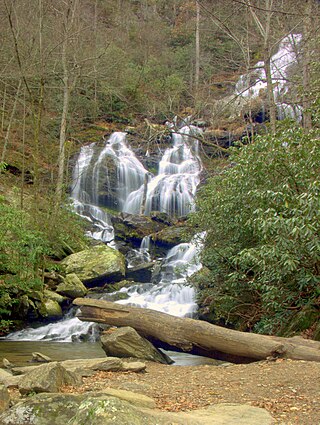
Catawba Falls is a series of waterfalls on the headwaters of the Catawba River, in McDowell County, near Old Fort, North Carolina.
The Fonta Flora State Trail is a unit of the North Carolina state park system in Buncombe, McDowell, and Burke Counties, North Carolina in the United States, and it consists of 90 acres (36 ha) of conservation land and 19 miles (31 km) designated multi-use trail. The State Trail is planned as a continuous route for hikers and cyclists from Asheville to Morganton, with a loop around Lake James. The trail is a collaboration between local governments, local land conservancies the US Forest Service, and the state, with development coordinated by the North Carolina Division of Parks and Recreation (NCDPR).
Hickory Nut Gorge State Trail is a unit of the North Carolina state park system in Rutherford, Buncombe, and Henderson Counties, North Carolina in the United States. The State Trail is planned as a continuous loop for hikers around Hickory Nut Gorge. The trail is a collaboration between local governments and the state, with development coordinated by the North Carolina Division of Parks and Recreation (NCDPR).
Jacob Fork is a 41.09 mi (66.13 km) long 4th order tributary to South Fork Catawba River in Burke and Catawba Counties, North Carolina.

Mayo River State Park is a state park of Virginia located in Henry County, along the North and South Forks of the Mayo River. The entrance to the park is located in Spencer. The park is located along the Virginia-North Carolina state line, and it is adjacent to a similarly named park in North Carolina.
References
- 1 2 3 4 5 6 "Session Law 2019-20". Raleigh, North Carolina: General Assembly of North Carolina. June 3, 2019. Retrieved July 29, 2019.
- ↑ "Potential State Park Along the Henry Fork and Jacob Fork Rivers" (PDF). City of Hickory. September 18, 2018. Retrieved July 29, 2019.
- ↑ "Jacob Fork State Natural Area Authorization". Raleigh, North Carolina: General Assembly of North Carolina. May 24, 2018. Retrieved July 29, 2019.
- ↑ "Agenda - Sept 17, 2018" (PDF). Catawba County Board of Commissioners. September 17, 2018. p. 62. Retrieved July 29, 2019.
- ↑ "Agenda Hickory City Council" (PDF). City of Hickory. October 2, 2018. pp. 12–15. Retrieved July 29, 2019.
- ↑ "Minutes" (PDF). City of Newton. October 2, 2018. p. 2. Retrieved July 29, 2019.
- ↑ Griffin, Kevin (September 20, 2018). "Proposed state park gets OK from Hickory, county". Hickory Daily Record. Retrieved July 29, 2019.
- 1 2 Griffin, Kevin (September 23, 2018). "Is time ripe for our first state park? Lawmaker says it could attract 1 million visitors annually". Hickory Daily Record. Retrieved July 29, 2019.
- 1 2 3 Griffin, Kevin (June 5, 2019). "State commits to adding Catawba County to trail system". Hickory Daily Record. Retrieved July 29, 2019.
- 1 2 3 "Agenda" (PDF). City of Hickory. February 5, 2019. pp. 11–13. Retrieved July 29, 2019.
- 1 2 Griffin, Kevin (January 17, 2019). "City OKs 161-acre donation to support state park plans" (PDF). Hickory Daily Record. Retrieved July 29, 2019.
- 1 2 "Foothills Conservancy of North Carolina purchases land for new park in Catawba County". Foothills Conservancy of North Carolina. May 12, 2019. Retrieved July 29, 2019.
- 1 2 3 4 Griffin, Kevin (May 9, 2019). "State park plan takes major step, says Sen. Wells". Hickory Daily Record. Retrieved July 29, 2019.
- 1 2 Ramlagan, Nadia (May 13, 2019). "Land in Catawba County Could Become Next NC State Park". Public News Service. Retrieved July 29, 2019.
- 1 2 Murphy, Chrissy (April 28, 2019). "Bill could connect Valdese to South Mountains". Morganton Herald. Retrieved July 29, 2019.
- 1 2 Epley, Justin (May 30, 2019). "Trail bill passed, presented to governor for approval". Morganton Herald. Retrieved July 29, 2019.
- ↑ Conley, Mike (July 22, 2019). "New laws authorize new trails for McDowell". McDowell News. Retrieved July 29, 2019.
